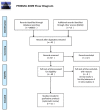Bowel ischemia in COVID-19: A systematic review
- PMID: 34605117
- PMCID: PMC8646310
- DOI: 10.1111/ijcp.14930
Bowel ischemia in COVID-19: A systematic review
Abstract
Background: Gastrointestinal complications of COVID-19 have been reported over the last year. One such manifestation is bowel ischaemia. This study thus aims to provide a more holistic review of our current understanding of COVID-19-induced bowel ischaemia.
Method and results: A meticulous search was performed using different keywords in PubMed and Google Scholar. Fifty-two articles were included in our study after applying inclusion and exclusion criteria and performing the qualitative assessment of the studies. A total of 25 702 patients were included in our study after the completion of the qualitative assessment.
Discussion: The common symptoms of GIT in COVID-19 patients are as diarrhoea, vomiting, nausea and abdominal pain. The mechanism of bowel ischaemia is associated with the formation of emboli which is related to COVID-19's high affinity for angiotensin-converting enzyme-2 on enterocytes, affecting the superior mesenteric vessels. Clinically, patients present with abdominal pain and vomiting. CT angiography of the abdomen and pelvis showed acute intestinal ischaemia (mesenteric). Management is usually initiated with gastric decompression, fluid resuscitation, and haemodynamic support. Surgical intervention is also sought.
Conclusion: Intestinal ischaemia presenting in patients with COVID-19 has to be considered when symptoms of severe abdominal pain are present. More research and guidelines are required to triage patients with COVID-19 to suspect intestinal ischaemia and to help in diagnosis and management.
© 2021 John Wiley & Sons Ltd.
Figures
References
Publication types
MeSH terms
LinkOut - more resources
Full Text Sources
Medical



